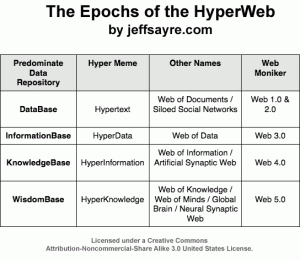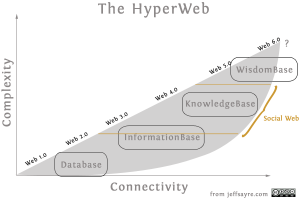The HyperWeb: it's All About Connections
I recently came across this interesting graphic entitled Hierarchy of Visual Information. The author clearly states that it is a work in progress, just the genesis of an idea, a not-fully-formed thought. In fact, he rightly points out that this–in general–is not a new concept at all and provides a link to a Google image search result showing many incarnations of the data-information-knowledge-wisdom concept.
As I looked at his graphic, a different idea came to mind, a different interpretation of the concept in the context of the Web's evolution. The hierarchical nature of the illustration made me think of the increasing complexity that comes with increasing connectivity. It made me think of how hyperlinks (more precisely hypertext) preceded hyperdata.
I realized that the hyper meme can be extended to the various evolutionary stages of the Web. So, I'm presenting what I call the HyperWeb.
The HyperWeb
The HyperWeb is about increasing connectivity and the increasing complexity of those connections overtime. The chart below outlines a few of the salient features that I believe best describe each stage, or epoch, of the HyperWeb. This is my twist to the traditional data-information-knowledge-wisdom concept.
Complexity is an emergent property of the increasing connectivity, not a direct result of the Web's technical foundation and framework. But there's a twist. There is a positive feedback loop that can cause more connections to be made as the system becomes more complex. Connectivity and complexity thus feed on one another, accelerating the rate of change and pushing the Web faster toward its asymptotic future.
The graph below shows the HyperWeb's epochs plotted against connectivity and complexity. The straight line shows the approximate points where most people assume the various Web epochs will emerge—a nice linear, one-to-one relationship. In reality though, the HyperWeb's phase transitions live on an asymptotic curve, they are not linear. The asymptotic curve demonstrates that the initial stages of the Web's evolution are slow but greatly accelerate with increasing connectivity.
I've placed the Social Web in the Web 2.5 to Web 4.5 range. If it occurs, that is the zone in which I expect it to materialize, thrive, and then die. What's that last point? Read on.
Whereas the Web seems far away from Web 5.0, you may be wondering what will the World look like if the Web ever evolves to Web 5.0? You might also wonder what the heck is Web 6.0?
For one possible set of answers to those questions, you'll have to wait for my upcoming article, to be released in the coming weeks, entitled Cybernetics, the Social Web, and the Coming Singularity.
The HyperWeb May Not Reach its Full Potential
It's important to point out that, just like natural speciation, the continued evolution of the HyperWeb is not guaranteed. As with all evolutionary processes, advancements (innovations) may stop at a certain point.
The Web is a democratizing force that can help redistribute power. That is antithetical to most large companies interests—and a number of countries as well. Apple, Twitter, Facebook–and of course the phone and cable companies–want as much control as possible. They are fighting for control of the Web, not for the health of the Web.
It's possible that for political, societal, or economic reasons–or some combination thereof–that the HyperWeb's evolution may be curtailed. For instance, due to myopic business leaders, scared political leaders, or an uneducated, apathetic citizenry, humanity's journey on the HyperWeb may not progress past Web 2.0 or Web 3.0.
Each new Web epoch will bring opportunities and uncertainties. The changes will be transformational, reshaping global society. If the Web continues to evolve to higher and higher levels, individuals will increasingly be the main benefactors, not business or politics. As such, the vision and drive to bring each new paradigm shift to fruition will come more and more from the Web's users and not the Web's businesses—although revolutionary advances in technology will be required all along the way.
If society wants a truly Social Web, then people need to fight for the Web, to help push it past its 2.0 version, past its current limitations and restrictive user control. The HyperWeb will continue to evolve only if the Web's netizens make it so.
My Related Articles
The Web is Not (yet) Social
My four-part series, Web 3.0: Powering Startups to Become Smartups
Jeff Sayre's Blog



